
Things have changed a lot since the days of 'semaphore' indicators. Or how about the ultra-stylish 'night driving signal glove' (invented way back in 1934)? Our modern flashing direction indicators are a lot more efficient than the old methods.
 Whatever signalling method you use, you must ensure that other road users know wat you mean; this means you must consider how others might interpret, or misinterpret, your signals.
Whatever signalling method you use, you must ensure that other road users know wat you mean; this means you must consider how others might interpret, or misinterpret, your signals.
Most of the time, when driving, we don't (personally) know the other people we share the road with. Despite this fact, we trust our safety to these strangers every time we go out as pedestrians, cyclists, passengers on public transport or drivers.
We warn children about the dangers of talking to strangers, but when we are driving, talking to strangers is essential. You do this by using signals shown in the Highway Code.
Keeping in mind that you know nothing about the people you share the roads with, your signalling 'language' must make your intentions clear. That's why Highway Code signalling rules are so important.
Always give signals when they will help or warn other road users - but you must also do everything you can to make sure you don't mislead or confuse anyone.
For example:
 You might think that you are flashing your headlights to say 'thank you' to someone who has just given way to you – but other drivers might see the signal and think you are giving way to them. (See the 'The Flasher' in this lesson).
You might think that you are flashing your headlights to say 'thank you' to someone who has just given way to you – but other drivers might see the signal and think you are giving way to them. (See the 'The Flasher' in this lesson).
Another common communication problem is caused by drivers who forget to cancel their indicator signals. Although most indicators are self-cancelling, you should always check to ensure they are switched off. This is especially important when changing lanes or in other situations where your steering wheel might not turn enough to cancel the signal.
There are eight legitimate ways to 'talk' to other road users. Each one is described in this lesson.
This is an old 'semaphore' indicator from long, long ago!
It's essential to use signals effectively during the test, and you must only use officially authorised signals for their intended use.
Using the horn to say hello to your friends or flashing your headlights to give way to other road users would not be acceptable!
During your driving test, the examiner will be watching to make sure that you:
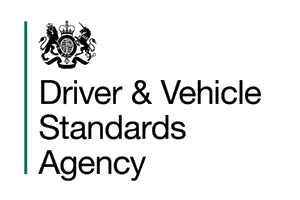
Use signals where necessary
Do not give unnecessary signals
Time your signals correctly
Do not mislead others with your signals
Take appropriate action when other people give signals
Make sure that signals are cancelled after use
All motor vehicles are fitted with direction indicators at the front, sides and rear so that other road users can see your signals.
 As well as using your indicators to show people which direction you intend to go, you can also use arm signals. Even if you never use arm signals, you need to be able to recognise them so that you understand what they mean if another driver or rider uses them.
As well as using your indicators to show people which direction you intend to go, you can also use arm signals. Even if you never use arm signals, you need to be able to recognise them so that you understand what they mean if another driver or rider uses them.
The rules below apply to all signals but are especially important when giving directions signals.
Your signals must be given
Where necessary
Correctly
In good time
Without misleading others
Signals help, warn or give information to other people. With this in mind, if another road user will benefit from the signal, you must always consider giving one.
When we talk about other road users, we don't just mean drivers - pedestrians, cyclists, motorcyclists, horse riders and others all need to know your intentions so that they can plan their actions to fit in with what you are doing.
Sometimes you might not be sure whether you need to give a signal. Generally, if you have checked your mirrors and know what other people are doing around you, it's probably okay to signal. To double-check, ask yourself, "Will this signal confuse anyone?" If the answer is no, go ahead and give the signal.
We said earlier that you should only use the signals shown in the Highway Code - by doing this, there is less chance of accidentally misleading others. Another critical point is that you should only use signals for their intended purpose. For example, using the horn to say 'hello' to a friend could startle a cyclist or pedestrian.
Click here to download the Highway Code signals information (pdf file from the Government website).
Getting your signal timing right is essential. If you signal too early or too late, it can confuse people.
One way to get signal timing right is to ensure that your indicators flash at least three times before starting the next part of your manoeuvre.
Three times before you start to brake
Three times before you start to accelerate
Three times before you start to make a position change
The 'three flashes rule' is a minimum. There will be lots of situations where common sense tells you that you need more than three flashes before starting to manoeuvre – your common sense about signal use will grow as you gain experience.
Many people forget that signals are advance warnings.
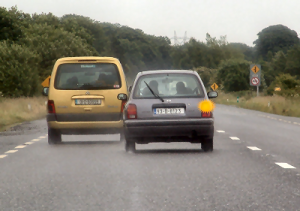
The photo shows the first flash of a driver's indication to overtake, but signalling this late is no help to anyone.
It was clear that the driver intended to overtake before the signal came on as the car had already started to pull out - this might suggest that they were signalling out of habit and hadn't checked the mirrors first.
On this occasion, there was no problem. But if someone else had been overtaking, there could have been a crash.
It's always important to think about how your signals will affect other drivers. You have already read one example of a potentially misleading signal (then horn) here's another:
If you use a right turn indicator signal every time you pass a parked car, you might confuse the driver behind if you go on to make a right turn further along the road. This could cause a bit of a shock when you slow down to turn! Seeing your right turn signal, the following driver might think you are just pulling out to pass another car.
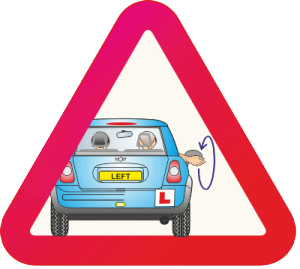
Arm signals were dropped from the UK driving test in 1975. Before 1975, the examiner would ask test candidates to drive for a short time using arm signals only.
You can still use arm signals during the driving test to reinforce indicator signals and brake lights, but not to replace them. In reality, arm signals are rarely used these days, but it is still useful to know about them.
Knowing about arm signals could be helpful to 'get you home' in the event of an indicator or brake light failure – but unfortunately, you won't be able to use them if your indicators or brake lights fail during a driving test.
During the test, your car has to comply with the regulations – if the examiner becomes aware that your indicators or brake lights are not working correctly, the test will be terminated.
Bearing in mind that it's illegal to drive with defective signals or other lights, it's a good idea to make sure that you make regular checks and carry spare bulbs!
In addition to being useful if your indicators or brake lights fail, you need to know about arm signals to understand signals given by cyclists, motor cyclists and horse riders.
The information below explains three everyday situations where arm signals can be helpful.
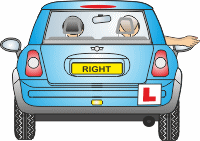
If you signal to turn right just as you approach a parked vehicle on your left, following drivers, or pedestrians who are thinking about crossing the side road that you want to turn into, might think that you are simply indicating to pass the parked vehicle.
By giving a right-turn arm signal in addition to your indicator signal you will reinforce your intention to turn.
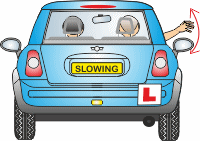
Because Zebra Crossings are uncontrolled (there are no traffic lights to tell you when to stop), drivers approaching from the opposite direction will not know that you intend to stop for a pedestrian. A slowing down arm signal tells these drivers that you are slowing down to stop.
The arm signal also reinforces the brake lights for drivers behind and can be helpful for pedestrians who will then be ready to cross as soon as you stop.
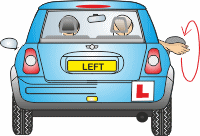
When intending to stop just before or after a junction, an arm signal can reinforce or replace an indicator signal.
For example (diagram):
If the driver of the green car wants to reverse into the junction on the left (A), they will stop just beyond it (B). If they indicate left using direction indicators, the driver of the red car might think that it's safe to pull out, expecting the green car to turn left into the side road.
On the other hand, if the driver of the green car waits until they are alongside the junction before signalling, it could be too late to warn the driver of the blue car following behind.
In this situation, a left turn arm signal would be visible to the driver behind you but would not be easily seen by the driver waiting to pull out of the junction.
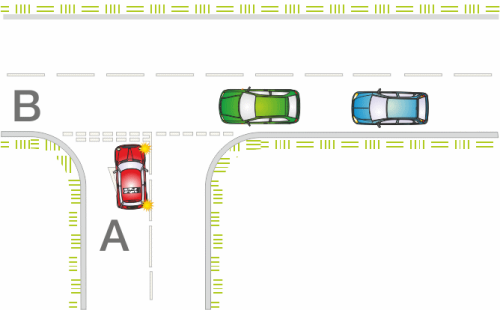
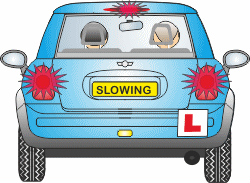
When you press the footbrake, your brake lights warn following drivers that you are slowing down.
Sometimes it can be helpful to touch the brake pedal very lightly to switch on the brake lights without slowing down*. Doing this gives drivers who are following too closely a bit more time to react when you start to slow down.
Because the brake lights are a signal, you need to check your mirrors before pressing the brake pedal – to find out who you are talking to and consider the timing of your braking.
* Important note:
Do not confuse touching the brake pedal lightly, as described above, with the dangerous use of brake lights to signal someone to 'back off'. If you feel that the driver behind is following too closely, let them pass – that way, if they have an accident, you will be less likely to be involved.
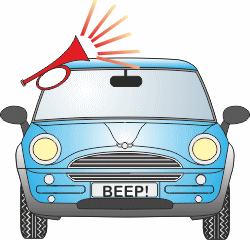
The horn is a 'warning instrument' and must be used early if it's going to be of any use.
There is not much point in using your horn if you are angry because someone has just pulled out in front of you. It might make you feel better, but you could upset the other driver.
Drivers who are upset can be dangerous.
They might drive nervously, paying too much attention to the mirror rather than the road ahead. Alternatively, they could stop you and pull out a big knife in response to your 'unsociable behaviour'.
Look well ahead, and if someone looks like they might be about to pull out without seeing you, use the horn to draw their attention to your presence. It can often be a good idea to acknowledge with a friendly wave when the driver looks at you.
The horn can also be helpful when your view is restricted. For example at a narrow hump-back bridge. But remember that the horn is NOT an alternative to the brake pedal - you must always slow down if there is danger.
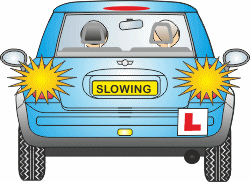
The hazard warning light switch turns on all the car's direction indicators simultaneously. You can usually find it in the centre of the dashboard.
Your hazard warning lights can be used to emphasise that your vehicle is parked.
Make sure that you are in a position where the lights are visible to the front and rear on both sides. Otherwise, people who see only one light might mistake it for a direction indicator and pause for you to pull out.
Hazard lights are not an excuse for bad parking!
If your car breaks down and you have to leave it where it could obstruct other traffic, switch on your hazard warning lights as soon as possible.
When you do your weekly vehicle check, you can use the hazard lights to check that all your indicators are working.
The Highway Code (Rule 116) says:
"You MUST NOT use hazard warning lights while your vehicle is moving unless you are on a motorway or unrestricted dual carriageway and you need to warn drivers behind you of a hazard or obstruction ahead. Only use them for long enough to ensure that your warning has been observed".
It's acceptable to use hazard warning lights on the move at times of danger when rapid deceleration is required, for example, approaching a motorway traffic jam.
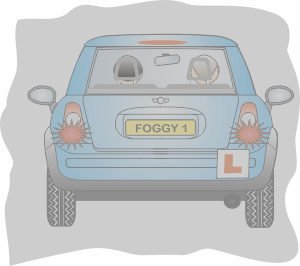
Fog lights are generally not considered to be signals, but they should be! (At least in the case of rear fog lights.)
Like the horn and flashing headlights, fog lights warn others of your presence and should only be used for as long as necessary to fulfil that task.
In other words, it's a good idea to switch off your rear fog lights as soon as the driver behind is close enough to see you.
Leaving your rear fog lights on when other vehicles are close behind could lead to the following driver being dazzled - and bumping into your car! They can see you clearly enough without needing fog lights when they are close.
If you switch off your fog lights to make life easier for the driver behind, make sure you switch them on again if the driver drops back, turns off or parks.
Rain and mist are not a reason for using your fog lights - it's illegal to use them unless the visibility is reduced to less than 100 metres by thick fog, heavy spray, or similar conditions.
Front fog lights should only be used when driving in dense fog - they can make it easier for others to see you and make it easier for you to see the road edge in very thick fog at night.
Use front fog lights if visibility is seriously reduced (less than 100 metres), but you must switch them off when the visibility improves. Also consider switching them off if there is a possibility that they could distract the driver in front - especially at night.
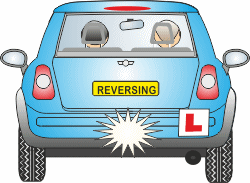
Reversing lights show other people that you are in reverse gear and moving backwards or likely to move backwards.
Reversing lights can also help you reverse safely after dark by illuminating the road behind your car.
As reversing lights act as a signal to others, it's just as important to consider when to switch them on as it is with the timing of any other signal.
Timing is especially the case when doing the parallel parking manoeuvre - when they will need to be switched on as soon as you stop before reversing. (The lights are switched on automatically when you select reverse gear.)
You will learn about using your reversing lights as signals when you cover the specific manoeuvres that include reversing.

Like the horn, flashing headlights warn other road users of your presence. They should not be used for any other reason.
Although you know who you are flashing at and what you mean, others might not.
For example, if you flash to give way to a bus that is stopped on the left-hand side of the road and indicating to pull out while at the same time there is a driver waiting to pull out of a driveway on the right you could create a dangerous situation.
You are concentrating on bus and your signal is for the bus driver, but the driver who is waiting to pull out on the right might think that the signal is for them and pull out when they see your flash. Crash!
See Highway Code Rules 110 and 111 about flashing headlights by clicking here.
 Signals Quiz
Signals QuizClick here to complete the quiz for this lesson
(The page will open in a new window/tab)
You will find references for the answers in this lesson.
You can check your answers as you go along, or complete the full quiz before checking.
Leaving the check to the end is a good way to test yourself.
When you check or review your answers you will get a brief explanation of the answer.
Good Luck!